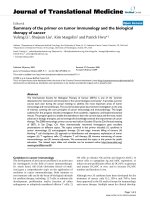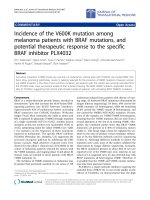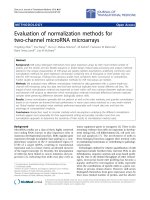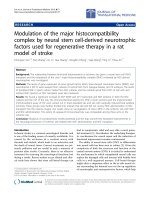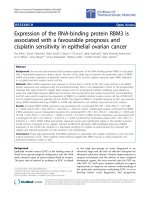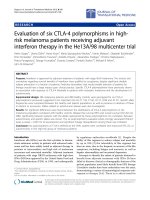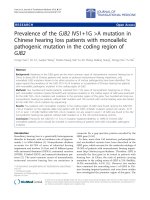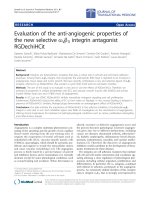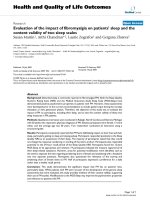báo cáo hóa học:" Evaluation of the late life disability instrument in the lifestyle interventions and independence for elders pilot (LIFE-P) study" ppt
Bạn đang xem bản rút gọn của tài liệu. Xem và tải ngay bản đầy đủ của tài liệu tại đây (681.96 KB, 10 trang )
RESEARC H Open Access
Evaluation of the late life disability instrument in
the lifestyle interventions and independence for
elders pilot (LIFE-P) study
Fang-Chi Hsu
1*
, W Jack Rejeski
2
, Edward H Ip
1
, Jeff A Katula
2
, Roger Fielding
3
, Alan M Jette
4
,
Stephanie A Studenski
5
, Steven N Blair
6
, Michael E Miller
1
Abstract
Background: The late life disability instrument (LLDI) was developed to assess limitations in instrumental and
management roles using a small and restricted sample. In this paper we examine the measurement properties of
the LLDI using data from the Lifestyle Interventions and Independence for Elders Pilot (LIFE-P) study.
Methods: LIFE-P participants, aged 70-89 years, were at elevated risk of disability. The 424 participants were
enrolled at the Cooper Institute, Stanford University, University of Pittsburgh, and Wake Forest University. Physical
activity and successful aging health education interventions were compared after 12-months of follow-up. Using
factor analysis, we determined whether the LLDI’s factor structure was comparable with that reported previously.
We further examined how each item related to measured disability using item response theory (IRT).
Results: The factor structure for the limitation domain within the LLDI in the LIFE-P study did not corroborate
previous findings. However, the factor structure using the abbreviated version was supported. Social and personal
role factors were identified. IRT analysis revealed that each item in the social role factor provided a similar level of
information, whereas the items in the personal role factor tended to provide different levels of information.
Conclusions: Within the context of community-based clinical intervention research in aged populations, an
abbreviated version of the LLDI performed better than the full 16-item version. In addition, the personal subscale
would benefit from additional research using IRT.
Trial registration: The protocol of LIFE-P is consistent with the principles of the Declaration of Helsinki and is
registered at (registration # NCT00116194).
Background
Disability is a major focus for intervention research in
aging due to the social, personal, and economic c osts
associated with the loss of independence [1]. The mag-
nitude of this problem will intensify with the aging of
the ‘baby boom’ generation. Consistent with the Interna-
tional classification of functioning, Disability, and Health
(ICF) framework [2], disability is now conceptualized as
arubricforcapturingimpairments, functional limita-
tions, and a ctivity restrictions. Jette an d his colleagues
[3] have noted that most existing instruments f ocus on
assessing discrete functional tasks to the exclusion of
performance on socially defined tasks expected of an
individual within a typical sociocultural and physical
environment. Thus, they developed the Late Life Dis-
ability Instrument (LLDI), a 16-item measure t o assess
limitations and frequency of performing life roles and
activities [3].
The Lifestyle Interventions and Independence for
Elders Pilot (LIFE-P) study was a single blind four-
center randomized controlled trial of a 12-month physi-
cal activity (PA) intervention compared to a successful
aging (SA) intervention in sedentary older adults. The
LLDI was used to measure change in disability within
randomized groups of LIFE-P. Because the original
LLDI was developed on a small, restricted sample, prior
* Correspondence:
1
Department of Biostatistical Sciences, Wake Forest University School of
Medicine, Winston-Salem, North Carolina, USA
Full list of author information is available at the end of the article
Hsu et al. Health and Quality of Life Outcomes 2010, 8:115
/>© 2010 Hsu et al; licensee BioMed Central Ltd. This is an Open Access article distributed under the terms of the Creative Commons
Attribu tion License ( which permits unrestricted use, distribution, and reproduction in
any medium, provided the original work is properly cite d.
to measuring change in the LLDI within LIFE-P, we
undertook an investigation to re-examine the measure-
ment properties of the instrument. The longitudinal
design of LIFE-P enabled us to examine the stability of
thefactorstructureoftheLLDI as disability responsive
to change with time and to evaluate the quality of indi-
vidual items.
We initially use confirmatory factor analysis to investi-
gate whether the factor structure for the limitation
domain of the LLDI, as applied to baseline and follow-
up data obtained from LIFE-P participant s, was compa-
tible with the originally publication. Furthermore,
because McAuley and colleagues [4] published an abbre-
viated version of the LLDI consisting of 8 items that had
superior psychometric qualities as compared to the ori-
ginal instrument, we examine the fit of their measure-
ment model within the LIFE-P data. Finally, to further
elucidate how individual items play a role in measuring
disability, we present results from item response theory
(IRT) for evaluating the relationship between disability
and item responses at month 12.
Methods
Study Sample
In LIFE-P, at baseline, 6- and 12-months, c omprehen-
sive standard assessments were conducted by trained
research staff blinded to intervention assignment [5-7].
The study was approved by the NIH and local institu-
tional review boards at the four clinic sites and all study
participants gave written informed consent. Between
May 2004 and F ebruary 2005, 424 participants at ele-
vated risk of disability were enrolled. Participants were
aged 70-89 years and able to complete a 400-meter walk
in 15 minutes. Major exclusion criteria included pre-
sence of severe heart failure, uncontrolled angina, and
other severe illnesses that might interfere with physical
activity. Detailed inclusion/exclusion criteria and a flow
diagram regarding to the specific numbers of individuals
screened and reasons for exclusion can be found in an
earlier publication [7].
Instrument
The Late Life Disability questionnaire includes items for
a wide variety of life tasks, such as personal mainte-
nance; mobility and travel; exchange of information;
social, community, and civic activities; home life; paid or
volunteer work; and involvement in economic activities
[3]. It was developed to assess meaningful concepts of
disability in terms of frequency and limitation in perfor-
manceof16lifetasks,andwas originally developed on
a sample of 150 community-dwelling older adults aged
60 and older. In this study, we focused on limitation
domain only. The limitation dimension describes cap-
ability of performing these life tasks. It includes both
personal (health, physical, or mental energy) and envir-
onmental (transportation, accessibility, or socioeco-
nomic) factors. Limitation questions are phrased, “to
what extent do you feel limited in doing a particu lar
task?” with response options of “notatall,”“a little,”
“ somewhat,”“alot,” and “completely.” Jette et al. [3]
demonstrated that two d isability domains, instrumental
and management, were identified within limitation
dimension for 16 items. McAuley et al. [4] identified
two domains, social and personal roles, using the abbre-
viated version with 8 items only.
Participant Characteristics
We obtained data on participant’ s age, gender, race/eth-
nicity, education, marital status, and living arra ngements
using a structured personal interview. Prevalence of
clinical conditions, including heart condi tion, chronic
pulmonary condition, anxiety/depression, stroke,
diabetes, high blood pressure, hip fracture, liver disease,
and cancer, was determined using self-reported physi-
cian-diagnosed disease information [5]. The mean
disability limitation total scaled score was calculated as
described by Jette et al. [3].
Statistical analysis
Participant Characteristics in the LLDI developmental
sample and the LIFE-P at Baseline were compared. Per-
centage was presented for categorical variables and
mean was presented for continuous variables.
Factor structure evaluation
We compared our LIFE-P factor solutions with those
from Jette et al [3] and McAuley et al. [4] using the 16
items and 8 items, respectively. Exploratory Factor Ana-
lysis (EFA) with principal extraction and orthogonal
rotation was used at baseline, 6-months and 12-months
to determine the factor structure f rom the LIFE-P. One
and two factor solutions were selected to allow for com-
parisons to the solutions published previously. A vari-
max rotation w as used to obtain a set of independent
and best i nterpretable factors. The factors were inter-
preted based on the factor loadings which relate the
items to putative underlying factors. The analysis was
performed after combing the two intervention groups
and also stratified by the two groups.
Subsequently, we applied Confirmatory Factor Analy-
sis (CFA) at baseline, 6-months, and 12-months to
check whether the factor structure for the limitation
domain from the LLDI was compatible with the original
publications [3,4]. Maximum likelihood estimation in
SAS 9.1 (Cary, NC) was used and has re sulted in accu-
rate fit indices with ordered categorical data [8]. The
chi-square goodness-of-fit test was performed first. For
large samples, it is very s ensitive and is liberal in rejec-
tion of the null hypothesis that the model fits the data.
Hsu et al. Health and Quality of Life Outcomes 2010, 8:115
/>Page 2 of 10
Additional indicators, includin g the comparative fit
index (CFI) [9], non-normed index [10], normed coeffi-
cient (NFI) [10], and root mean squared error approxi-
mation coefficient (RMSEA) [11] were also investigated.
Values approximating 0.90 f or CFI, non-normed index,
and NFI are indicative of good model fit to the data.
A RMSEA value of less than or equal to 0.1 corresponds
to an “ acceptable” fit, and 0.05 or lower indicates a
“good” fit.
Item-level analysis
As an item-level exploration, we applied IRT analysis
within each factor for the 12-month data. The month
12 visit was selected because at that visit participants
exhibited a wider amount of variation in level of disabil-
ity and we reason ed that data from this visit might
more closely resemble the samples used in previous
publications. For easier interpretation purpose, we
divided the scale for each limitation item into the fol-
lowing two groups: the “less limitation” classification
included responses of “ notatall,”“a little,” and “some-
what” ,whereasthe“ a lot of limitation” classification
included responses of “alot,” and “ completely”.Item
parameters were generated including difficulty (location)
and discriminatio n (slope or correlation) [12]. It is
assumed that the behavior of the items is invariant to
the sample to which the items are appli ed. Item charac-
teristic curves were generated to display the probability
of a positive response to each item as a function of dis-
ability. In addition, a second graph, the item information
function, was generated to indicate the effectiveness of
an item in measuring different levels of disability. The
Multilog program Version 7.0 (Assessment Systems
Corporation, St. Paul, MN) was used for analysis.
Results
Table 1 contain s the participant characteristics in LIFE-
P at baseline and the LLD developmental sample. The
sample size in LIFE-P (424) is larger than that in the
LLD developmental sample (150). The majority of L IFE-
P participants were aged 70-79 (72.9%). In contrast, the
LLD developmental sample ranged in age from 60 years
to more than 90 years, with 40.7% of the LLD develop-
mental sample aged 70-79. Both studies ha d a large per-
centage of women. The LIFE-P sample had 18.2% that
self-report ed race as black compared with 7.3% for LLD.
The LIFE-P participants reported a higher level of
attained education compared to the LLD developmental
sample. A slightly greater percentage of LIFE-P partici-
pants reported currently living with their spouse. The
mean disability limitation total scaled score was slightly
higher in LIFE-P. Within LIFE-P, the scal ed scores were
slightly lower at baseline than months 6 and 12. This
suggests that the participants may have been more likely
to participate in life tasks at the follow-up visits in
LIFE-P and that LIFE-P participants may have been
more capable of participating i n life tasks compared to
the LLD developmental sample. In general, the LIFE-P
participants reported a greater burden of comorbidit ies,
including a higher prevalence of anxiety/depression, dia-
betes, and cancer.
The study design, recruitment, and participant charac-
teristics of McAuley et al. [4] have been described in
detail elsewhere [4]. Briefly, there were 250 black
(32.4%) and white (67.6%) women recruited to partici-
pate in a 24-month prospective study of women’shealth
behaviors. Their mean age (68.1 ± 6.1) was 8.7 years
younger than LIFE-P participants. Most (91.5%) were
high school graduates. This sample reported less cardio-
vascular diseases (8.8%) and more pulmonary disease
(15.6%) compared to the other two study samples The
percentages of diabetes (12.4%) and cancer (6%) were
higher than the LLD developmental sample and lower
than the LIFE-P sample (data not shown).
Factor structure evaluation
There were not many missing LLDI items in the LIFE-P
study; the rates of missing items were below or equal to
1% for all items except one (“work at a volunteer job” at
baseline) was 2%. Results f rom EFA are presented in
Table 2. To allow a comparison w ith the original factor
analysis performed by Jette et al., the items and factor
loadings for one- and two-factor models are shown.
Concentrating first on the two-factor solution, and
using the 0.45 loading criterion, we found that five
items (“visit friends”, “go out to public places”, “keep in
touch with others”, “participate in social activities”, “take
care of local errands”) loaded on the factors differently
at the three time points. With the exception of these
items, the remaining items consistently loaded on these
factors across time. When comparing the two-factor
solution at month 12 t o that reported by Jette et al [3],
seven of the items that loaded on the first factor were
among the twelve items that loaded on the first factor
reported by Jette et al.; two of the items that loaded on
the second factor were among the four items that
loaded on the second factor reported by Jette et al; and
seven of the items had inconsistent loadings. The one-
factor model was slightly more consistent across time (a
= 0.89, 0.91, and 0.91 for baseline, month 6, and month
12, respectively). The results stratified by intervention
groups were similar; thus, we only presented the overall
results.
Since the result of our factor analysis was not compar-
able to that reported by Jette et al., we further applied
EFA to the eight items (the abbreviated version)
reported by McAuley et al. [4]. Adopting the same fac-
tor names that were used by McAuley et al. [4] ("social
role” and “personal role” ), we found that four items
Hsu et al. Health and Quality of Life Outcomes 2010, 8:115
/>Page 3 of 10
Table 1 Comparison of Participant Characteristics in the LLDI Developmental Sample and LIFE-P at Baseline
a
Characteristic LLD Developmental Sample
b
(Percentage)
LIFE-P
N 150 424
Age
60-69 27.3 0
70-79 40.7 72.9
80-89 26.7 27.1
90+ 5.3 0
Gender – Women 77.3 68.9
Race
White 84.0 74.3
Black 7.3 18.2
Asian 2.7 0.7
Hispanic 5.3 4.7
American Indian 0.7 0.9
Other 0 1.0
Missing 0 0.2
Education
High School or less 38.7 30.0
Bachelor/certificate degree 44.7 45.8
Graduate/professional degree 16.6 21.2
Other 0 2.8
Missing 0 0.2
Marital Status—Married 39.3 39.5
Living Arrangements
Alone 45.3 45.1
With spouse (only) 33.3 39.2
With family 18.0 14.4
With nonfamily 3.4 1.4
Disability Limitation Scaled Score - mean
Total 68.6 69.3, 71.4, 71.2
c
Instrumental Role 67.2 68.7, 71.1, 70.8
Management Role 86.3 83.8, 84.9, 84.7
Self-Reported Conditions
Heart condition 10.0 13.0
d
Chronic pulmonary condition 10.0 13.7
Anxiety/depression 6.0 29.7
Stroke 6.0 4.7
Diabetes 3.3 17.7
Hip fracture 2.6 3.1
Liver disease 2.6 2.6
Cancer 1.3 17.5
a
except disability limitation scaled score which has been presented at three time points.
b
From Jette et al (2002)
c
The numbers are in order: baseline, month 6, and month 12.
d
Combine heart failure and heart attack.
Hsu et al. Health and Quality of Life Outcomes 2010, 8:115
/>Page 4 of 10
Table 2 Estimates of Factor Loadings for Models for Limitation from LIFE-P
a. Baseline 16 items from Jette et al. Original 8 items from McAuley et al.
One factor Two factor One factor Two factor
Items Factor 1 Factor 2 Social role Personal role
Visit friends 0.58
a
0.40 0.43 0.62 0.70 0.14
Travel out of town 0.66 0.59 0.33 0.68 0.71 0.23
Go out to public places 0.73 0.57 0.46 0.76 0.73 0.33
Work at a volunteer job 0.69 0.73 0.20
Keep in touch with others 0.50 0.19 0.55
Participate in social activities 0.73 0.64 0.36
Invite family and friends into home 0.70 0.64 0.33 0.71 0.74 0.24
Participate in active recreation 0.55 0.77 -0.07
Provide assistance to others 0.64 0.54 0.35
Provide meals 0.64 0.37 0.56 0.69 0.34 0.66
Take care of personal care needs 0.53 0.12 0.69 0.60 0.05 0.84
Take care of local errands 0.70 0.47 0.53 0.73 0.40 0.65
Take care of health 0.56 0.08 0.78
Take care of household business 0.56 0.17 0.68 0.57 0.26 0.56
Take part in an exercise program 0.63 0.74 0.09
Take care of inside of home 0.68 0.61 0.32
b. Month 6 Follow-Up
One factor Two factor One factor Two factor
Items Factor 1 Factor 1 Factor 2 Social role Personal role
Visit friends 0.63 0.63 0.21 0.63 0.80 0.09
Travel out of town 0.69 0.70 0.22 0.68 0.71 0.26
Go out to public places 0.71 0.64 0.33 0.72 0.65 0.36
Work at a volunteer job 0.68 0.74 0.16
Keep in touch with others 0.49 0.37 0.31
Participate in social activities 0.70 0.62 0.35
Invite family and friends into home 0.70 0.64 0.31 0.70 0.72 0.27
Participate in active recreation 0.61 0.73 0.06
Provide assistance to others 0.69 0.59 0.37
Provide meals 0.66 0.30 0.69 0.74 0.27 0.77
Take care of personal care needs 0.65 0.25 0.74 0.70 0.13 0.85
Take care of local errands 0.70 0.36 0.68 0.76 0.28 0.79
Take care of health 0.59 0.14 0.77
Take care of household business 0.58 0.19 0.71 0.63 0.41 0.48
Take part in an exercise program 0.67 0.66 0.24
Take care of inside of home 0.69 0.59 0.38
c. Month 12 Follow-Up
One factor Two factor One factor Two factor
Items Factor 1 Factor 1 Factor 2 Social role Personal role
Visit friends 0.60 0.36 0.49 0.62 0.76 0.14
Travel out of town 0.70 0.65 0.32 0.72 0.79 0.24
Go out to public places 0.73 0.55 0.49 0.79 0.70 0.43
Work at a volunteer job 0.69 0.68 0.28
Keep in touch with others 0.59 0.18 0.68
Participate in social activities 0.74 0.59 0.46
Invite family and friends into home 0.69 0.65 0.30 0.69 0.66 0.33
Participate in active recreation 0.62 0.79 0.05
Provide assistance to others 0.65 0.51 0.41
Provide meals 0.70 0.44 0.56 0.76 0.30 0.76
Take care of personal care needs 0.66 0.33 0.62 0.71 0.21 0.78
Hsu et al. Health and Quality of Life Outcomes 2010, 8:115
/>Page 5 of 10
("visit friends”, “travel out of town” , “go out to public
places” ,and“ invite family and friends into home” )
loaded highly on limitations in capabilities to perform
social tasks and four items ("provide m eals”, “take care
of personal care needs”, “take care of local errands”, and
“take care of household business”) loaded highly on lim-
itations for personal tasks (Table 3). The result was con-
sistent with McAuley et al [4].
Results from the CFA for the limitation domain of
the LLDI from LIFE-P are provided in Table 3. Initi-
ally, we tested the fit of one and two factor models for
the 16-item limitation domain u sing baseline data. The
one-factor model did not present a good fit to the
data. The two-factor model performed better fo r these
baseline data; however, as described above, the result
was difficult to interpret. Subsequently, we applied
similar confirmatory factor analyses to the data col-
lected at the 6-month and 12-month visits. Results
were similar across visits, with fit statistics indicating a
slight improvement in fit for both one and two-factor
solutions at these two visits. Across all visits, the two-
factor solution consistently outperformed the one-
factor solution; however, as described above the two-
factor solution was als o difficult to interpret . More-
over, results from CFA using the abbreviated version
showed a reasonable fit to the data. The two-factor
model performed better compared to the one-factor
model at the d ifferent time points (Table 3).
Item-level analysis
IRT was subsequently used to empirically assess the
relation between the factor and each of the four items
(abbreviatedversion)thatloaded highly on the specific
factor at month 12 in the LIFE-P participants. Results
from this analysis are presented in Figures 1 and 2. The
IRT analysis revealed that the level of information pro-
vided by each of the four items in the social role factor
were consistent (Figure 1), and items in the personal
role factor tended to provide different levels of informa-
tion (Figure 2). For example, the item “take care of local
errands” provided high discriminating power and a high
level of information at a moderate level of disability,
whereas the other three items did not appear to be
highly informative across disability levels.
Table 3 Confirmatory Factor Analyses for Limitation Domain in Late Life Disability Questionnaire from LIFE-P
16 items from Jette et al.
Time No. of Factors Chi-Square df p-value Goodness of Fit Index CFI
a
Non-normed Index NFI
b
RMSEA
c
Baseline 1 512.9 104 <.0001 0.8484 0.8302 0.8313 0.7971 0.0991
2 321.7 89 <.0001 0.9008 0.9034 0.9046 0.8727 0.0808
Month 6 1 438.3 104 <.0001 0.8499 0.8621 0.8630 0.8278 0.0926
2 237.4 89 <.0001 0.9205 0.9388 0.9396 0.9067 0.0667
Month 12 1 403.7 104 <.0001 0.8727 0.8832 0.8839 0.8497 0.0872
2 282.4 89 <.0001 0.9103 0.9246 0.9255 0.8949 0.0757
Original 8 items from McAuley et al.
Time No. of Factors Chi-Square df p-value Goodness of Fit Index CFI Non-normed Index NFI RMSEA
Baseline 1 61.9 20 <.0001 0.9620 0.9534 0.9538 0.9333 0.0710
2 19.2 13 0.1182 0.9890 0.9932 0.9933 0.9794 0.0337
Month 6 1 140.3 20 <.0001 0.9042 0.8832 0.8841 0.8674 0.1251
2 40.5 13 0.0001 0.9741 0.9733 0.9736 0.9617 0.0743
Month 12 1 115.5 20 <.0001 0.9219 0.9109 0.9116 0.8950 0.1118
2 35.8 13 0.0006 0.9777 0.9788 0.9791 0.9675 0.0677
a
CFI: comparative fit index.
b
NFI: normed coefficient.
c
RMSEA: root mean squared error approximation coefficient.
Table 2: Estimates of Factor Loadings for Models for Limitation from LIFE-P (Continued)
Take care of local errands 0.71 0.41 0.62 0.74 0.21 0.82
Take care of health 0.59 0.14 0.72
Take care of household business 0.58 0.14 0.71 0.60 0.28 0.56
Take part in an exercise program 0.68 0.74 0.20
Take care of inside of home 0.71 0.65 0.34
a
The bolded loadings are greater than 0.45.
Hsu et al. Health and Quality of Life Outcomes 2010, 8:115
/>Page 6 of 10
Figure 1 IRT analysis for social role factor.
Hsu et al. Health and Quality of Life Outcomes 2010, 8:115
/>Page 7 of 10
Figure 2 IRT analysis for personal role factor.
Hsu et al. Health and Quality of Life Outcomes 2010, 8:115
/>Page 8 of 10
Discussion
The factor structure for the limitat ion domain using the
16 items within the LLDI in LIFE-P study did not corro-
borate the findings reported by Jette et al [3]. The two-
factor solution was not ideal and difficult to interpret.
However, the factor structure using the eight items, the
abbreviated versi on proposed by McAuley et al. [4], was
supported by the LIFE-P data. Although only older
women were recruited in McAuley et al. [4], the abbre-
viated version was still applicable in a study that
included both older men and women like the LIFE-P.
Two factors, soc ial and personal roles, were identified
using the abbreviated versi on. One of the attractive fea-
turesoftheshortformisthatitretainstheoriginal
ideas originally put forth by Jette et al. [3], yet reduces
participan t burden. Moreover, the IRT analysis revealed
that the level of information provided by each item in
the social role factor was consistent, but the items in
thepersonalrolefactorprovideddifferentlevelsof
information.
There are several possible reasons why we were
unable to confirm the originally published factor struc-
ture of the LLDI. First, because the sample size from
the LLD developmental sample was small, those results
maybeunstable.Ideally,theLLDIshouldbeevaluated
in large, population-based samples. Second, LIFE-P was
a community-based clinical trial and the study partici-
pants may not be representative of the LLDI develop-
mental sample. For example, from Table 1, it is clear
that LIFE-P participants are well-educated and not as
healthy as those in the original study published by J ette
et al. However, it is worth noting that the range and
severity of disability in the two samples were quite simi-
lar. And third, responses to the individual items may
differ between the two samples due to external factors.
For exampl e, time of year may be a confounder for cer-
tain items. Specifically, people may keep in touch more
with others around the holidays than at other times of
the year. This confounder may also contribute to why
we did not observe consistent factor loadings across the
three time points.
The item-level analysis indicates that the level of
information for social roles provided by each of the four
items was consistent, showing that the stated activities
are of equal importance in capturing late life activities.
However, items on the sec ond factor - personal role -
tend to pr ovide different levels of information. For
example, most participants seem to be able to take care
of essential household business, as reflected in the low
difficulty item parameter and low information of the
household business item. However, participants may not
have the cap acit y or wil ling ness to perform non-essen-
tial local errands.
So what is the take home message and where should
research with the LLDI go from here? First, we see no
advantage of u sing the long form over the short form
and would suggest that investigators use the brief 8-
item LLDI in future research. Second, application of
item-responsetheorytotheLLDIshortformoffered
support for the content of the social subscale, but it was
mixed for items making up the personal subscale .
Future research is needed with the personal subscale in
populations that have greater difficulty with basic activ-
ities of daily living (ADLs). In particular, even though
the physical functioning of LIFE-P participants was
comp romised somewhat, these individuals did live inde-
pendently in the community. The personal subscale may
be more appropriate for studies conducted within senior
living communities in which older adults often have dif-
ficulty with one or more basic ADL. This also raises the
more general issue of using the LLDI i n both large epi-
demiological studies and smaller controlled trials. Unless
the population of interest involves older adults that
either have or are likely to experience deficits in func-
tioning that c ompromise very basic social and personal
activities, the LLDI should not be used. Third, LIFE-P
collected the LLDI at three different time points: appli-
cation of factor analysis to each time point may not be
the most efficient way (from a statistical analysis point
of view) to evaluate the properties of the questionnaire.
Accordingly, it is crucial for methodologists to develop
methods that can incorporate the factor data at different
time points while considering the possible different fac-
tor structure at each time point.
Conclusions
In summary, we contrasted LLDI results from LIFE-P
and two other studies [3,4]. The abbreviated version
using eight items performed better in our study sample
and we would recommend it for use in future research.
Given the item content of the LLDI and the results of
our analyses, we would conclude that this instrument is
best used with older adults that have or are likely to
develop impairments which are likely to influence very
basic social and personal activities. In addition, the per-
sonal subscale would benefit from additional research
using IRT in these target populations.
Acknowledgements
The Lifestyle Interventions and Independence for Elders Pilot (LIFE-P) Study
was funded by a grant from the National Institutes of Health/National
Institute on Aging (U01 AG22376) and supported in part by the Intramural
Research Program, National Institute on Aging, NIH. The Wake Forest
University Field Center was partially supported by the Claude D. Older
American Independence Pepper Center (1P30AG21332). Dr. Fielding’s
contribution was partially supported by the U.S. Department of Agriculture,
under agreement No. 58-1950-4-401. The Pittsburgh Field Center was
Hsu et al. Health and Quality of Life Outcomes 2010, 8:115
/>Page 9 of 10
partially supported by the Pittsburgh Claude D. Pepper Center P30
AG024827.
The Lifestyle Interventions and Independence for Elders Study Group: Cooper
Institute, Dallas, TX: Steve Blair, Timothy Church, Jamile A. Ashmore, Judy
Dubreuil, Alexander N. Jordan, Gina Jurca, Ruben Q. Rodarte, Jason M.
Wallace; National Institute on Aging: Jack M. Guralnik, Evan C. Hadley, Sergei
Romashkan; Stanford University, Palo Alto, CA: Abby C. King, William L. Haskell,
Leslie A. Pruitt, Kari Abbott-Pilolla, Karen Bolen, Stephen Fortmann, Ami
Laws, Carolyn Prosak, Kristin Wallace; Tufts University, Boston, MA: Roger
Fielding, Miriam Nelson; University of California, Los Angeles, Los Angeles:
Robert M. Kaplan; University of California, San Diego: Eric J. Groessl; University
of Florida, Gainesville: Marco Pahor, Connie Caudle, Lauren Crump, Tonya
Kelley; University of Pittsburgh, PA: Anne B. Newman, Bret H. Goodpaster,
Stephanie Studenski, Erin K. Aiken, Steve Anthony, Nancy W. Glynn, Judith
Kadosh, Piera Kost, Mark Newman, Christopher A. Taylor, Pam Vincent; Wake
Forest University, Winston-Salem, NC, Field Center: Stephen B. Kritchevsky, Peter
Brubaker, Jamehl Demons, Curt Furberg, Jeffrey A. Katula, Anthony Marsh,
Barbara J. Nicklas, Kimberly Kennedy; Shruti Nagaria, Rose Fries, Katie
Wickley-Krupel; Data Management and Quality Control Center: Michael E.
Miller, Mark A. Espeland, Fang-Chi Hsu, Walter J. Rejeski, Don P. Babcock, Jr.,
Lorraine Costanza, Lea N. Harvin, Lisa Kaltenbach, Wesley A. Roberson, Julia
Rushing, Michael Walkup; Yale University, New Haven, CT: Thomas M. Gill.
Author details
1
Department of Biostatistical Sciences, Wake Forest University School of
Medicine, Winston-Salem, North Carolina, USA.
2
Department of Health and
Exercise Science, Wake Forest University, Winston-Salem, North Carolina, USA.
3
Nutrition, Exercise Physiology, and Sarcopenia Laboratory, Jean Mayer USDA
Human Nutrition Research Center on Aging, Tufts University, Boston,
Massachusetts, USA.
4
Health and Disability Research Institute, School of
Public Health, Boston University, Boston, Massachusetts, USA.
5
Division of
Geriatric Medicine, University of Pittsburgh, Pittsburgh, Pennsylvania, USA.
6
Department of Exercise Science and Department of Epidemiology and
Biostatistics, the Arnold School of Public Health, University of South Carolina,
Columbia, South Carolina, USA.
Authors’ contributions
FCH, WJR, EHI, and AMJ: study concept and design, analysis and
interpretation of data, preparation of manuscript. JAK and RF: study concept
and design, preparation of manuscript. SAS: acquisition of data. SNB and
MEM: acquisition of data, study concept and design, analysis and
interpretation of data, preparation of manuscript. All authors read and
approved the final manuscript.
Competing interests
No other potential competing interest relevant to this article was reported.
Received: 24 May 2010 Accepted: 6 October 2010
Published: 6 October 2010
References
1. Fried LP, Guralnik JM: Disability in older adults: evidence regarding
significance, etiology, and risk. J Am Geriatr Soc 1997, 45:92-100.
2. World Health Organization: International classification of functioning,
disability, and health (ICF). 2001.
3. Jette AM, Haley SM, Coster WJ, Kooyoomjian JT, Levenson S, Heeren T,
Ashba J: Late life function and disability instrument: I. Development and
evaluation of the disability component. J Gerontol A Biol SCi Med Sci 2002,
57:M209-M216.
4. McAuley E, Konopack JF, Motl RW, Rosengren K, Morris KS: Measuring
disability and function in older women: psychometric properties of the
late-life function and disability instrument. J Gerontol A Biol Sci Med Sci
2005, 60:901-909.
5. Rejeski WJ, Fielding RA, Blair SN, Guralnik JM, Gill TM, Hadley EC, King AC,
Kritchevsky SB, Miller ME, Newman AB, Pahor M: The lifestyle interventions
and independence for elders (LIFE) pilot study: design and methods.
Contemporary Clin Trials 2005, 26:141-154.
6. Katula JA, Kritchevsky SB, Guralnik J, Glynn NW, Pruitt L, Wallace K,
Walkup MP, Hsu FC, Studenski SA, Gill TM, Groessl EJ, Wallace JM, Pahor M:
Lifestyle interventions and independence for elders pilot study:
recruitment and baseline characteristics. J Am Geriatr Soc 2007,
55:674-683.
7. The LIFE study investigators: Effects of a physical activity intervention on
measures of physical performance: results of the Lifestyle Interventions
and Independence for Elders Pilot (LIFE-P) Study. J Gerontol A Biol Sci
Med Sci 2006, 61A:1157-1165.
8. Hutchson SR, Olmos A: Behavior of descriptive fit indices in confirmatory
factor analysis using ordered categorical data. Struct Equat Model 1998,
5:344-364.
9. Bentler PM: Comparative fit indices in structural models. Psychological
Bulletin 1990, 107:238-246.
10. Bentler PM, Bonett DG: Significance tests and goodness of fit in the
analysis of covariance structures. Psychological Bulletin 1980, 88:588-606.
11. Steiger JH, Lind JC: Statistically-based tests for the number of common factors
Paper presented at the annual spring meeting of the psychometric society
in Iowa city; 1980.
12. Steinberg L, Thissen D: In Item response theory in personality research. Edited
by: Shrout PE, Fiske ST. Personality research, methods, and theory: A
festschrift honoring Donald W. Fiske. Hillside. NJ: Lawrence Erlbau; 1995:.
doi:10.1186/1477-7525-8-115
Cite this article as: Hsu et al.: Evaluation of the late life disability
instrument in the lifestyle interventions and independence for elders
pilot (LIFE-P) study. Health and Quality of Life Outcomes 2010 8:115.
Submit your next manuscript to BioMed Central
and take full advantage of:
• Convenient online submission
• Thorough peer review
• No space constraints or color figure charges
• Immediate publication on acceptance
• Inclusion in PubMed, CAS, Scopus and Google Scholar
• Research which is freely available for redistribution
Submit your manuscript at
www.biomedcentral.com/submit
Hsu et al. Health and Quality of Life Outcomes 2010, 8:115
/>Page 10 of 10
